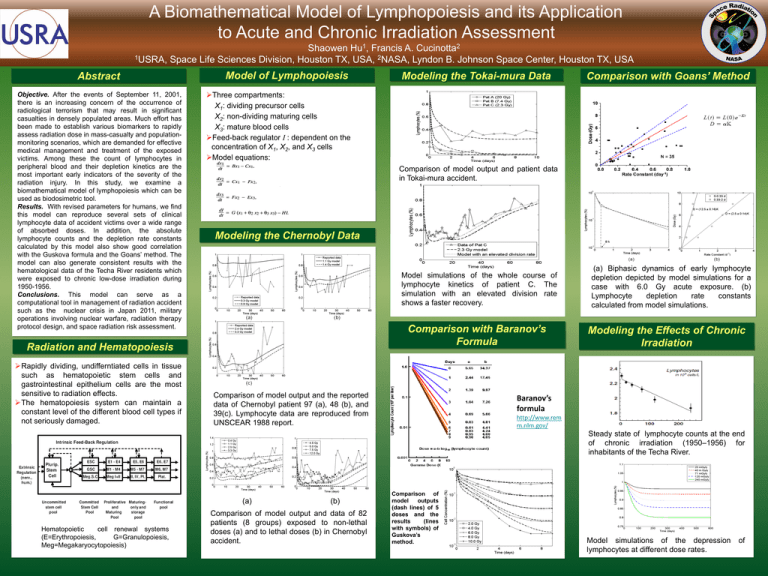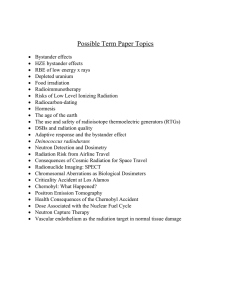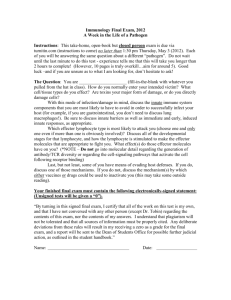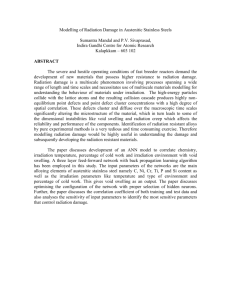A Biomathematical Model of Lymphopoiesis and its Application
advertisement

A Biomathematical Model of Lymphopoiesis and its Application to Acute and Chronic Irradiation Assessment 1 Hu , 2 Cucinotta Shaowen Francis A. 1USRA, Space Life Sciences Division, Houston TX, USA, 2NASA, Lyndon B. Johnson Space Center, Houston TX, USA Abstract Objective. After the events of September 11, 2001, there is an increasing concern of the occurrence of radiological terrorism that may result in significant casualties in densely populated areas. Much effort has been made to establish various biomarkers to rapidly assess radiation dose in mass-casualty and populationmonitoring scenarios, which are demanded for effective medical management and treatment of the exposed victims. Among these the count of lymphocytes in peripheral blood and their depletion kinetics are the most important early indicators of the severity of the radiation injury. In this study, we examine a biomathematical model of lymphopoiesis which can be used as biodosimetric tool. Results. With revised parameters for humans, we find this model can reproduce several sets of clinical lymphocyte data of accident victims over a wide range of absorbed doses. In addition, the absolute lymphocyte counts and the depletion rate constants calculated by this model also show good correlation with the Guskova formula and the Goans’ method. The model can also generate consistent results with the hematological data of the Techa River residents which were exposed to chronic low-dose irradiation during 1950-1956. Conclusions. This model can serve as a computational tool in management of radiation accident such as the nuclear crisis in Japan 2011, military operations involving nuclear warfare, radiation therapy protocol design, and space radiation risk assessment. Model of Lymphopoiesis Comparison with Goans’ Method Three compartments: X1: dividing precursor cells X2: non-dividing maturing cells X3: mature blood cells Feed-back regulator I : dependent on the concentration of X1, X2, and X3 cells Model equations: Comparison of model output and patient data in Tokai-mura accident. Modeling the Chernobyl Data Model simulations of the whole course of lymphocyte kinetics of patient C. The simulation with an elevated division rate shows a faster recovery. Comparison with Baranov’s Formula Radiation and Hematopoiesis Rapidly dividing, undifferntiated cells in tissue such as hematopoietic stem cells and gastrointestinal epithelium cells are the most sensitive to radiation effects. The hematopoiesis system can maintain a constant level of the different blood cell types if not seriously damaged. Modeling the Tokai-mura Data Comparison of model output and the reported data of Chernobyl patient 97 (a), 48 (b), and 39(c). Lymphocyte data are reproduced from UNSCEAR 1988 report. (a) Biphasic dynamics of early lymphocyte depletion depicted by model simulations for a case with 6.0 Gy acute exposure. (b) Lymphocyte depletion rate constants calculated from model simulations. Modeling the Effects of Chronic Irradiation Baranov’s formula http://www.rem m.nlm.gov/ Steady state of lymphocyte counts at the end of chronic irradiation (1950–1956) for inhabitants of the Techa River. (a) Hematopoietic cell renewal systems (E=Erythropoiesis, G=Granulopoiesis, Meg=Megakaryocytopoiesis) (b) Comparison of model output and data of 82 patients (8 groups) exposed to non-lethal doses (a) and to lethal doses (b) in Chernobyl accident. Comparison of model outputs (dash lines) of 5 doses and the results (lines with symbols) of Guskova’s method. Model simulations of the depression lymphocytes at different dose rates. of


